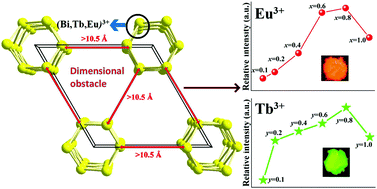Design, synthesis, crystal structure and luminescent properties of a new tantalum-phosphate K3BiTaP3O13 with negligible concentration quenching and good thermostability†
Abstract
The luminous efficiency of rare-earth (Ln3+)-doped luminescent materials suffers greatly from the negative concentration quenching effect, which can be surmounted by a large separation of Ln3+ ions in the host lattice. Herein, this study reports a novel tantalum-phosphate K3BiTaP3O13 (KBTP) that possesses a ‘chain-like’ structure when viewed along the c-axis, containing [TaO(PO4)2]∞, K∞ and [Bi(PO4)]∞ chains. UV-Vis spectroscopy and density functional theory (DFT) calculations reveal that K3BiTaP3O13 has an indirect band-gap of 3.99 eV, making it suitable as a luminescent host matrix. A series of Eu3+ or Tb3+ phosphors KBTP:xEu/Tb (x = 0.1–1) were prepared and their fluorescent performance was studied. Due to the Bi3+ ions being far apart in the KBTP host, the negative concentration quenching effect of the prepared phosphors was greatly limited, even when the concentration of Eu/Tb reached up to 80% replacing Bi3+. Moreover, both phosphors had good heat-resistance properties at 30–200 °C, keeping 85.6% (KBTP:0.8Eu) and 71.3% (KBTP:0.8Tb) of the initial intensity at 200 °C. These results preliminarily suggest that KBTP is promising as a host material for both Eu3+ and Tb3+ fluorescence.



 Please wait while we load your content...
Please wait while we load your content...